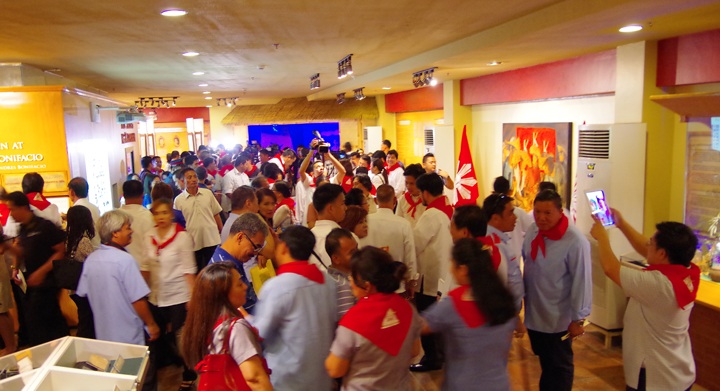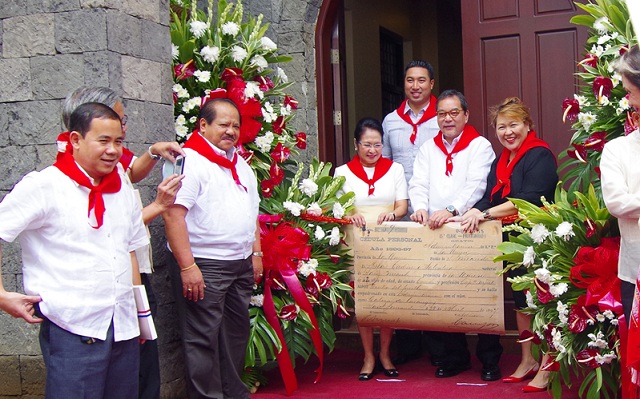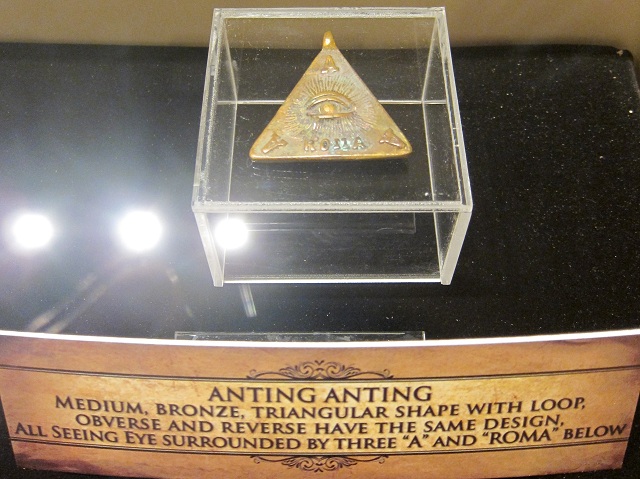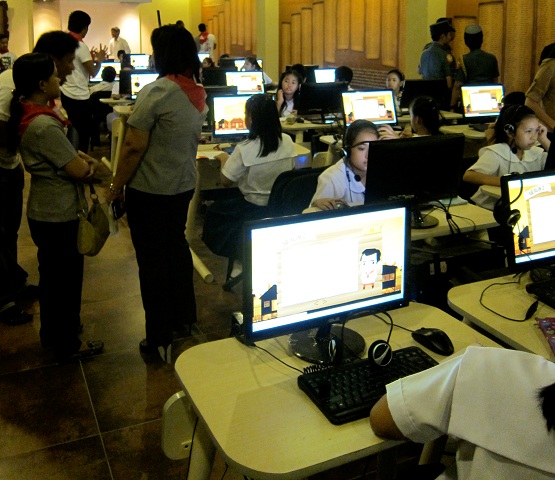ADVERTISEMENT
Filtered By: Lifestyle
Lifestyle
Museo ng Katipunan opens for Supremo's sesquicentennial
By SAMANTHA TERAN

Last week, the Museo ng Katipunan opened its doors to the public for the first time. Photo courtesy of Red Root Artists Cooperative
A facsimile of a cedula is torn in half before a cheering crowd—a symbolic gesture that signaled the opening of the first museum dedicated to one of the country's greatest heroes, Andres Bonifacio.
The inauguration of the Museo ng Katipunan at the Pinaglabanan Shrine in San Juan City on August 27, one of a series of events scheduled to celebrate 150 years since Bonifacio's birth, drew a sizeable crowd of visitors that included grade school students, scholars and public figures such as San Juan City Mayor Guia Gomez, National Historical Commission of the Philippines president Dr. Maria Serena Diokno, and Tourism Secretary Ramon Jimenez—wearing red kerchiefs tied around their shoulders in true Katipunan fashion.

The inauguration of the Museo ng Katipunan at the Pinaglabanan Shrine in San Juan City on August 27, one of a series of events scheduled to celebrate 150 years since Bonifacio's birth, drew a sizeable crowd of visitors that included grade school students, scholars and public figures such as San Juan City Mayor Guia Gomez, National Historical Commission of the Philippines president Dr. Maria Serena Diokno, and Tourism Secretary Ramon Jimenez—wearing red kerchiefs tied around their shoulders in true Katipunan fashion.

Instead of a ribbon-cutting, a more appropriate cedula-tearing officially opened the museum. Red Root Artists Cooperative
The museum’s opening was also the occasion of the launching of the book Forgotten Warriors of the Katipunan: Selected Excerpts from El Comercio, Diario dela Tarde, a collection of accounts translated into English by the late writer Umberto Lammoglia. His sister, writer and heritage conservationist Bambi Harper, was also at the event to say a few words about him and the publication of the book.
After the announcement of the winners of the Bonifacio stamp design contest and a lovely song number, it was finally time for the museum to open. In lieu of a ceremonial ribbon cutting, the large Spanish-era cedula was torn before the museum’s doors, a more fitting gesture for a museum honoring the men and women of the Katipunan.
Century-old artifacts
 If you found Philippine history a chore to pay due attention to in school, it’s not too late to learn about one of the country's most important figures. The Museo ng Katipunan combines intriguing relics from Bonifacio's life with a modern take on the museum-going experience.
If you found Philippine history a chore to pay due attention to in school, it’s not too late to learn about one of the country's most important figures. The Museo ng Katipunan combines intriguing relics from Bonifacio's life with a modern take on the museum-going experience.
Old weapons and anting-anting and copies of the original Katipunan documents are on display, and on the walls hang information about members of the Katipunan, including Bonifacio's wife Gregoria de Jesus, or Oryang as she was lovingly known, and Emilio Jacinto, the society's "brains."
Original works are also displayed, such as a love poem written by Oryang to Bonifacio.
Working with these in providing the guest with an enriching museum experience are the touch-screen tablets displaying accounts of the activities of the KKK accompanied by recorded voice-overs, and one of the museum's most impressive exhibits, a hologram of an actor playing Bonifacio reciting his "Pag-ibig sa Tinubuang Lupa" with passion.
Learning history by modern means
 Downstairs and separate from all this is the museum’s pièce de résistance, its e-learning room, where students from grades 5-7 of participating San Juan elementary schools can partake in online lessons for one hour starting at 9 a.m. from Monday to Friday.
Downstairs and separate from all this is the museum’s pièce de résistance, its e-learning room, where students from grades 5-7 of participating San Juan elementary schools can partake in online lessons for one hour starting at 9 a.m. from Monday to Friday.
The lessons do away with exhaustingly long reads and instead are concise and easy to understand, grouped in Aralin sets from 1 to 24. The graphics are fun and pleasing to any child’s eye, making the learning experience very enjoyable indeed.
Students were already in the room during the opening, the first to experience the more exciting take on what can be a wearying history lesson. The interactive lessons, which can be accessed from home as well on the NHCP website, offer insights on Rizal, Mabini, and the Malolos Congress in addition to Bonifacio. So far, the latter's is the only complete set on the list in accordance with the commemoration, but soon more lessons will be added to the site.
On the same floor as the e-learning room is a quaint and well-lit Silid ng Pananaliksik , where a collection of history books are on display and open for perusing and researching including copies of Noli Me Tangere and El Filibusterismo in their original print. Souvenirs are also available for sale just before you exit the museum.
It is to be hoped that Museo ng Katipunan’s mix of old and new ways of learning will draw the public, especially young people, promoting education and the kind of national pride that Bonifacio surely fought and died for. — BM, GMA News
The Museo ng Katipunan is at the Pinaglabanan Memorial Shrine, Pinaglabanan St., San Juan City. It is open from 8 a.m. to 4 p.m., Tuesdays - Sundays.
Reservations can be made by calling 576-4336 or 385-5896.
After the announcement of the winners of the Bonifacio stamp design contest and a lovely song number, it was finally time for the museum to open. In lieu of a ceremonial ribbon cutting, the large Spanish-era cedula was torn before the museum’s doors, a more fitting gesture for a museum honoring the men and women of the Katipunan.
Century-old artifacts

An anting-anting used by the Katipunan is on display in the museum. Photo by Samantha Teran
Old weapons and anting-anting and copies of the original Katipunan documents are on display, and on the walls hang information about members of the Katipunan, including Bonifacio's wife Gregoria de Jesus, or Oryang as she was lovingly known, and Emilio Jacinto, the society's "brains."
Original works are also displayed, such as a love poem written by Oryang to Bonifacio.
Working with these in providing the guest with an enriching museum experience are the touch-screen tablets displaying accounts of the activities of the KKK accompanied by recorded voice-overs, and one of the museum's most impressive exhibits, a hologram of an actor playing Bonifacio reciting his "Pag-ibig sa Tinubuang Lupa" with passion.
Learning history by modern means

The e-learning room, where students can learn about the Katipunan online. Samantha Teran
The lessons do away with exhaustingly long reads and instead are concise and easy to understand, grouped in Aralin sets from 1 to 24. The graphics are fun and pleasing to any child’s eye, making the learning experience very enjoyable indeed.
Students were already in the room during the opening, the first to experience the more exciting take on what can be a wearying history lesson. The interactive lessons, which can be accessed from home as well on the NHCP website, offer insights on Rizal, Mabini, and the Malolos Congress in addition to Bonifacio. So far, the latter's is the only complete set on the list in accordance with the commemoration, but soon more lessons will be added to the site.
On the same floor as the e-learning room is a quaint and well-lit Silid ng Pananaliksik , where a collection of history books are on display and open for perusing and researching including copies of Noli Me Tangere and El Filibusterismo in their original print. Souvenirs are also available for sale just before you exit the museum.
It is to be hoped that Museo ng Katipunan’s mix of old and new ways of learning will draw the public, especially young people, promoting education and the kind of national pride that Bonifacio surely fought and died for. — BM, GMA News
The Museo ng Katipunan is at the Pinaglabanan Memorial Shrine, Pinaglabanan St., San Juan City. It is open from 8 a.m. to 4 p.m., Tuesdays - Sundays.
Reservations can be made by calling 576-4336 or 385-5896.
Tags: katipunanmuseum, andresbonifacio
More Videos
Most Popular




